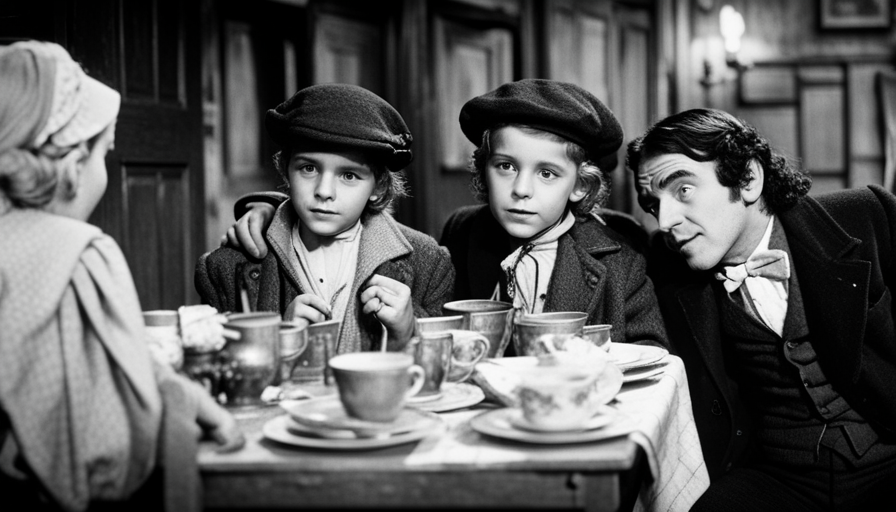Exploring the captivating world of Charles Dickens’ ‘A Christmas Carol,’ one particular scene stands out in my mind: the moment when the second spirit brings Scrooge to the Cratchit’s house.
It is a pivotal moment in the story, where we witness the heartwarming reunion of the Cratchit family and their beloved son, Tiny Tim. But amidst the joy and merriment, a question lingers in my mind: could Tiny Tim walk when the second spirit arrived?
In this article, I aim to explore the physical condition of Tiny Tim, the powers of the second spirit, and the significance of Tiny Tim’s ability to walk in the context of the story. Through a careful analysis of Dickens’ writing style and narrative choices, we will decipher the true meaning behind this scene and its impact on Scrooge’s transformation.
Join me on this journey of discovery as we unravel the mysteries surrounding Tiny Tim’s mobility and the profound implications it holds for the tale of ‘A Christmas Carol.’
Key Takeaways
- Tiny Tim’s inability to walk symbolizes the vulnerability and challenges faced by the less fortunate, highlighting the importance of compassion and empathy towards them.
- The second spirit’s powers to traverse time and space serve as a witness to the consequences of actions, but cannot alter past events, emphasizing the transformative power of redemption.
- Tiny Tim’s ability to walk represents the indomitable spirit of the human soul and the potential for transformation and triumph over adversity.
- Tiny Tim’s walking has a profound impact on Scrooge, leading to a shift in his perspective, newfound concern for others, and a fostering of connection and intimacy with the Cratchit family.
Analysis of Tiny Tim’s Physical Condition
Could Tiny Tim walk when the 2nd spirit took Scrooge to the Cratchit’s house? Let’s analyze Tiny Tim’s physical condition.
An examination of his medical condition reveals that Tim suffered from a debilitating leg deformity, which restricted his mobility. He relied on the use of crutches to move around, indicating his inability to walk independently. This condition symbolizes Tim’s vulnerability and the challenges he faced in his everyday life.
Despite his physical limitations, Tim’s spirit remained resilient and hopeful. His inability to walk serves as a poignant reminder of the hardships faced by the less fortunate.
Transitioning into the subsequent section about the examination of the second spirit’s powers, it is crucial to understand the impact it had on Tim and his family.
Examination of the Second Spirit’s Powers
Witness the astonishing abilities of the Second Spirit as it effortlessly transports you to the humble abode of the Cratchit family. This spectral being possesses the power to traverse time and space, allowing it to guide Ebenezer Scrooge on a transformative journey. However, it is important to understand that the Second Spirit’s powers are not without limitations. While it can grant Scrooge access to different places and moments, it cannot alter the events that have already occurred. It serves as a witness, shedding light on the consequences of past actions. This extraordinary ability to observe and reflect provides Scrooge with a profound understanding of the impact his choices have had on those around him. As we delve deeper into the story, we will compare the Second Spirit’s abilities to Tiny Tim’s, exploring the contrasting paths they each take.
Comparison to Tiny Tim’s Abilities Throughout the Story
Step into the realm of comparison as we explore the unique abilities possessed by the Second Spirit and Tiny Tim throughout the story, diving into their contrasting paths. But how do their powers differ and what impact do they have on the narrative?
-
Analysis of Tiny Tim’s Growth: Throughout the story, we witness Tiny Tim’s growth from a frail and disabled child to a symbol of hope and resilience. His ability to inspire compassion and kindness in others is a testament to his inner strength and determination.
-
Comparison to Other Characters’ Abilities: In contrast to the Second Spirit, who possesses supernatural powers to manipulate time and space, Tiny Tim’s abilities are more subtle yet equally impactful. While the Second Spirit serves as a catalyst for Scrooge’s transformation, Tiny Tim’s presence serves as a constant reminder of the power of love and empathy.
-
Evaluation of Scrooge’s Perspective on Tiny Tim’s Walking: As we delve into the evaluation of Scrooge’s perspective on Tiny Tim’s ability to walk, we begin to unravel the layers of Scrooge’s character and his journey towards redemption.
With this understanding of Tiny Tim’s growth and his unique abilities compared to other characters, we can now explore Scrooge’s perspective on Tiny Tim’s walking in the subsequent section.
Evaluation of Scrooge’s Perspective on Tiny Tim’s Walking
Scrooge’s perception of the remarkable ability displayed by Tiny Tim to move independently despite his physical limitations offers a profound insight into the transformative power of compassion and empathy. From the moment Scrooge witnesses Tiny Tim’s resilience and determination, his perspective on the young boy’s walking abilities begins to shift.
Scrooge’s initial skepticism and indifference towards Tiny Tim’s condition are gradually replaced by a growing sense of understanding and admiration. Through his evolving empathy, Scrooge starts to interpret Tiny Tim’s role not as a burden or a symbol of weakness, but as a symbol of hope and resilience. He realizes that Tiny Tim’s ability to walk, despite his physical challenges, represents the indomitable spirit of the human soul and serves as a reminder of the potential for transformation and redemption.
This interpretation sets the stage for the subsequent section, which delves into the symbolic importance of Tiny Tim’s ability to walk, highlighting its deeper meaning and significance in the story’s narrative.
The Symbolic Importance of Tiny Tim’s Ability to Walk
The flickering candle of hope illuminated by Tiny Tim’s unwavering footsteps brings warmth to the hearts of those around him, like a guiding star on a dark night. Tiny Tim’s ability to walk holds a symbolic significance in the story, as it represents the power of perseverance and the triumph of the human spirit over adversity.
Through his ability to walk, Tiny Tim becomes a symbol of hope and resilience, inspiring others to overcome their own challenges. Additionally, Tiny Tim’s walking serves as a catalyst for character development, as it prompts Scrooge to change his perspective and become more compassionate. Witnessing Tiny Tim’s ability to walk, Scrooge begins to question his own beliefs and values, leading him on a transformative journey towards redemption.
Transitioning into the next section, it’s essential to explore possible explanations for Tiny Tim’s walking in this scene.
Possible Explanations for Tiny Tim’s Walking in the Scene
Imagine yourself transported into the scene, surrounded by the flickering glow of the candlelight, as you try to uncover the possible explanations for the miraculous sight of Tiny Tim walking.
One possible explanation for Tiny Tim’s ability to walk could be an analysis of his medical condition. Perhaps his previous inability to walk was due to a temporary ailment or injury that was cured by the time the second spirit took Scrooge to the Cratchit’s house.
Another possible explanation could be the significance of the second spirit’s intervention. It’s possible that the spirit’s presence and influence somehow brought about a miraculous healing for Tiny Tim, allowing him to walk once again.
These explanations highlight the transformative power of the spirits in the story.
Moving forward, let’s explore the analysis of Dickens’ writing style and narrative choices.
Analysis of Dickens’ Writing Style and Narrative Choices
As we delve into the analysis of Dickens’ writing style and narrative choices, we gain a deeper understanding of the character development and the exploration of themes such as hope and redemption in the story.
Dickens, known for his vivid descriptions and emotive language, crafts a compelling tale that captivates readers. Through his meticulous attention to detail, he paints a vivid picture of Scrooge’s transformation and the impact it has on the Cratchit family, particularly Tiny Tim.
By choosing to have Tiny Tim walk when the second spirit takes Scrooge to the Cratchit’s house, Dickens emphasizes the power of Scrooge’s redemption and the hope it brings to those around him. This narrative choice underscores the central message of the story, highlighting the possibility of change and the importance of compassion.
With this understanding, we can now move on to the interpretation of the scene’s meaning in the context of the story.
Interpretation of the Scene’s Meaning in the Context of the Story
Now, try to envision the profound meaning behind the scene when Scrooge is led to the Cratchit family’s humble abode. In this pivotal moment, Dickens skillfully portrays the resilience of Tiny Tim, the youngest member of the Cratchit family, through his inability to walk. This serves as a powerful symbol of hope and determination amidst adversity. Despite his physical limitations, Tiny Tim’s spirit remains unbroken, and his condition becomes a poignant reminder of the challenges faced by the Cratchit family. Through his portrayal of Tiny Tim, Dickens highlights the importance of compassion and empathy towards those less fortunate. This scene prompts us to reflect on the significance of Tiny Tim’s condition in relation to the Cratchit family, emphasizing the strength and unity that they derive from their love for one another. As the story progresses, we will see how Tiny Tim’s resilience impacts Scrooge’s transformation, ultimately leading to his redemption.
The Impact of Tiny Tim’s Walking on Scrooge’s Transformation
Through the portrayal of Tiny Tim’s physical limitations, Dickens effectively conveys the profound impact on Scrooge’s transformation. Witnessing Tiny Tim’s ability to walk despite his disability causes a significant shift in Scrooge’s perspective. It serves as a catalyst for his empathy and compassion, leading to a gradual transformation of his character.
Scrooge’s initial reaction to Tiny Tim’s walking is one of astonishment and disbelief. This analysis of Scrooge’s reaction highlights the stark contrast between his previous indifference and his newfound concern for others.
Furthermore, Tiny Tim’s walking has a profound impact on Scrooge’s relationship with the Cratchits. It fosters a sense of connection and intimacy, as Scrooge begins to actively engage and care for their well-being. This analysis of the impact on Scrooge’s relationship with the Cratchits underscores the transformative power of Tiny Tim’s walking. It serves as a turning point in Scrooge’s journey towards redemption and serves as a reminder that change is possible for even the most hardened hearts.
As the discussion shifts towards the reader’s interpretation and personal opinions, it becomes clear that Tiny Tim’s walking is a pivotal moment in the story that resonates deeply with audiences.
Discussion of the Reader’s Interpretation and Personal Opinions
As we delve deeper into the impact of Tiny Tim’s ability to walk on Scrooge’s transformation, it’s important to address the interpretation controversy surrounding this topic.
While some readers argue that Tiny Tim’s ability to walk symbolizes hope and a brighter future for Scrooge, others believe that it represents the power of empathy and compassion. Personally, I find both viewpoints compelling as they highlight different aspects of Scrooge’s transformation.
The fact that there is room for interpretation speaks to the richness of Charles Dickens’ writing and the depth of his characters. It allows readers to form their own personal viewpoints and connect with the story on a deeper level.
Ultimately, whether or not Tiny Tim could walk when the second spirit took Scrooge to the Cratchit’s house is a question that invites us to reflect on the power of redemption and the potential for change within ourselves.
Frequently Asked Questions
How does Tiny Tim’s physical condition affect his relationship with his family?
Tiny Tim’s physical limitations greatly impact his family dynamics. His family members are constantly worried about his health and well-being, and they go to great lengths to provide him with the care and support he needs.
What is the significance of the Second Spirit’s powers in relation to Tiny Tim’s ability to walk?
The second spirit’s powers are significant in relation to Tiny Tim’s ability to walk. The spirit’s visit may have provided Tim with hope and inspiration, but it did not directly affect his physical condition.
How does the scene where Tiny Tim walks compare to his abilities throughout the rest of the story?
Throughout the story, Tiny Tim’s progression is highlighted by his ability to walk when the second spirit takes Scrooge to the Cratchit’s house. This scene demonstrates the impact of Scrooge’s transformation on Tim’s physical abilities.
Does Scrooge’s perspective on Tiny Tim’s ability to walk change after the Second Spirit’s visit?
Scrooge’s perspective on Tiny Tim’s ability to walk changes after the second spirit’s visit. Tiny Tim’s walking scene contrasts with his limited abilities throughout the story, symbolizing hope and optimism. This impacts his family and highlights the significance of the second spirit’s powers.
How does Tiny Tim’s ability to walk symbolize hope and optimism in the story?
Tiny Tim’s ability to walk symbolizes hope and optimism in the story. His condition impacts family dynamics by fostering love and compassion. The alliteration of his walk creates a vivid image of his determination and resilience.
Conclusion
In conclusion, the ability of Tiny Tim to walk when the Second Spirit took Scrooge to the Cratchit’s house serves as a powerful allegory. It symbolizes the transformative power of compassion and empathy in the face of adversity.
Dickens’ narrative choices and writing style effectively convey the importance of this scene in the context of the story. This pivotal moment has a profound impact on Scrooge’s transformation, highlighting the potential for change and redemption within each individual.
Ultimately, it’s up to the reader to interpret and form their own opinions on the significance of Tiny Tim’s walking.
Hi, I’m Emma. I’m the Editor in Chief of Tiny House 43, a blog all about tiny houses. While tree houses are often associated with childhood, they can be the perfect adult retreat. They offer a cozy space to relax and unwind, surrounded by nature. And since they’re typically built on stilts or raised platforms, they offer stunning views that traditional homes simply can’t match. If you’re looking for a unique and romantic getaway, a tree house tiny house might just be the perfect option.
















